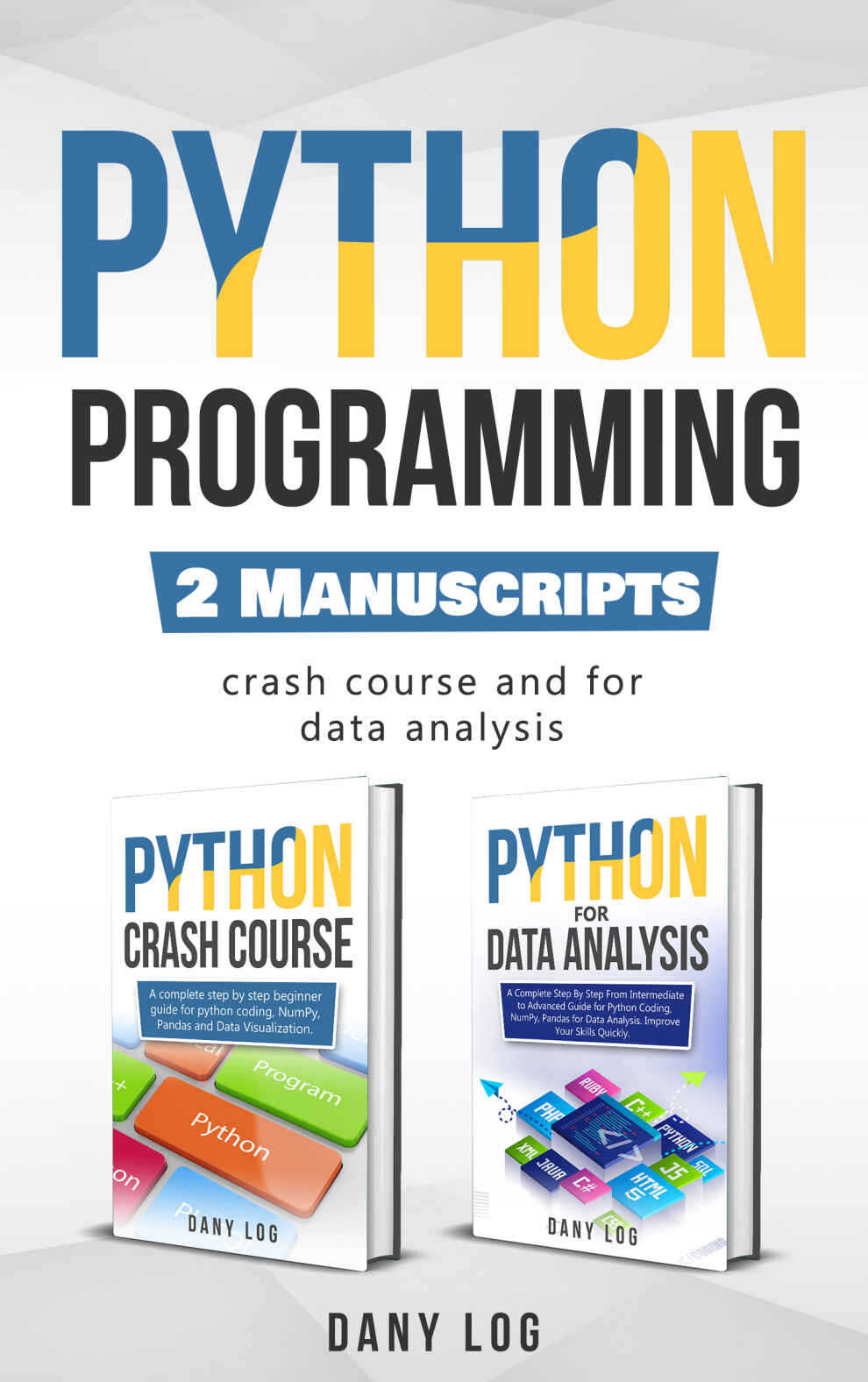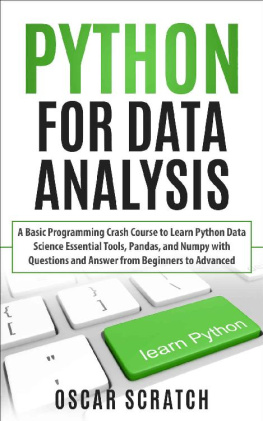Python programming
2 manuscripts - python crash course, python for data analysis
By
Dany Log
Copyright 2020 by Dany Log
All rights reserved.
The material contained herein is presented with the intent of furnishing pertinent and relevant information and knowledge on the topic with the sole purpose of providing entertainment. The author should thus not be considered an expert on the topic in this material despite any claims to such expertise, first-hand knowledge, and any other reasonable claim to specific knowledge on the material contained herein. The information presented in this work has been researched to ensure its reasonable accuracy and validity. Nevertheless, it is advisable to consult with a duly licensed professional in the area pertaining to this topic, or any other covered in this book, in order to ensure the quality and validity of the advice and/or techniques contained in this material.
This is a legally binding statement as deemed so by the Committee of Publishers Association and the American Bar Association in the United States. Any reproduction, transmission, copying, or otherwise duplication of the material contained in this work are in violation of current copyright legislation. No physical or digital copies of this work, both total and partial, may not be done without the Publishers express written consent. All additional rights are reserved by the publisher of this work.
The data, facts, and description of events forthwith shall be considered as accurate unless the work is deemed to be a work of fiction. In any event, the Publisher is exempt of responsibility for any use of the information contained in the present work on the part of the user. The Author and Publisher may not be deemed liable, under any circumstances, for the events resulting from the observance of the advice, tips, techniques and any other contents presented herein.
Given the informational and entertainment nature of the content presented in this work, there is no guarantee as to the quality and validity of the information. As such, the contents of this work are deemed as universal. No use of copyrighted material is used in this work. Any references to other trademarks are done so under fair use and by no means represent an endorsement of such trademarks or their holder.
Table of Contents
Python Crash Course
A Complete Step-by-Step Beginner Guide for Python Coding, NumPy, Pandas, and Data Visualization
Introduction
Who is meant to read this book?
This book Python Crash Course: A Complete Step-by-Step Beginner Guide for Python Coding, NumPy, Pandas, and Data Visualization is meant for any individual who is interested in Python programming. The experts who want to learn more. For beginners who want to learn everything and other professionals like finance and economy experts. Several individuals would like to earn from Python programming. You will learn all that from the book.
What will you learn from this book?
This book will clearly elaborate on the definition of Python programming, how you can use it, and the people who can benefit from it. There is enough information on what you can do with the information. You will get all the information you need on how important Python programming is to economists and in your workplace. Do you know that you can earn money from Python programming? If your answer is no, do not worry; all the information you need is clearly illustrated.
There are different concepts when it comes to Python programming, on the terms used, how to install Python, the courses offered, and what job you can get with Python skills. There are different operating systems that are used for Python programming like Linux, Windows, and OS X and how you can do troubleshooting. There are different variables and data types like classes, functions, and dictionaries. Data visualization and web applications are chapters that are important to learn and understand. You need to know what the list is, how to change, remove, add elements on the list, and you will know how to organize a list.
Chapter 1:
Python Programming
What is Python Programming?
This is a programming language that is objected-oriented and of high level and uses semantics. It is a high level in terms of structures in data and a combination of dynamic typing and binding. This is what makes it attractive to be used for Rapid Application Development and for connecting different elements.
Python with its simplicity and learning with ease helps in reading the programming language, and that is why it reduces the cost to maintain the program. Python encourages the program modularity and code reuse; this is because it supports different packages and modules. The standard library and the Python interpreter can be found in binary form. It is not necessary to charge all the available platforms and can be distributed freely.
Most programmers love the Python program because they offer great productivity. The edit-test debug is a cycle that is fast and does not need any compilation process. It is easier to debug a Python program; it will not cause any segmentation fault. An exception is raised when an error is discovered by the interpreter. When the exception is not known by the program, the interpreter prints a trace. The debugger, on a level of sourcing, will allow being inspecting any variables. There will be a settling of breakpoints, arbitrary expressions, and stepping on the code at any time. The Python is what writes the debugger, the easier, and a quick debugging method and programs of adding prints on the source and statements.
Python is open-source; this means you can use them freely for any commercial applications. Python is programmed to work on UNIX, Windows, and Mac and can be transferred to Java. Python is a language that helps in scripting and helps in web applications for different content.
It is like Perl and Ruby. Python is helped by several imaging programs; users are able to create customized extensions. There are different web applications supporting Python API like Blender and GIMP.
This information given on Python programming is beneficial for both the newbies and the experienced ones. Most of the experienced programmers can easily learn and use Python. There is an easier way to install Python. Most distributors of UNIX and Linux have the recent Python. That is the reason why most computers come already installed with Python. Before you start using Python, you need to know which IDEs and text editors best work with Python. To get more help and information, you can peruse through introductory books and code samples.
The Python idea was discovered in 1980 after the ABC language. Python 2.0 was introduced, it had features like garbage collection and list comprehensions; which are used in reference cycle collection. When Python 3.0 was released in 2008, it brought about a complete language revision. Python is primarily used for developing software and webs, for mathematics and scripting systems. The latest version of Python is known a Python 3 while Python 2 is still popular. Python was developed to help in reading and similar aspects to different languages like English and emphasis on Mathematics.
A new line is used to complete a Python command, as opposed to other programming languages that normally use semi-colons. It depends on indentation, whitespace, and defining the scope.





